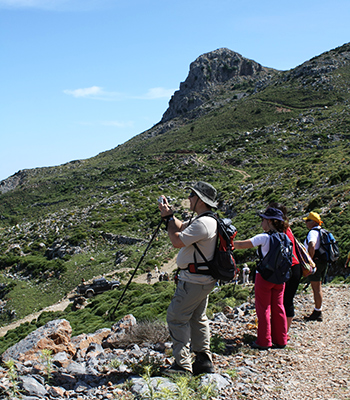 Karfi is the name of a mountain top located south of the village of Krassi, at an altitude of 1100m, which looks like a nail (Karfi in Greek) and has given its name to the wider. The ruins of one of the most important late-Minoan settlements are found here. The ancient name of the settlement was not preserved and thus it is known as "Minoan Settlement at Karfi".
Karfi is the name of a mountain top located south of the village of Krassi, at an altitude of 1100m, which looks like a nail (Karfi in Greek) and has given its name to the wider. The ruins of one of the most important late-Minoan settlements are found here. The ancient name of the settlement was not preserved and thus it is known as "Minoan Settlement at Karfi".
On this hill, there was originally a sanctuary from the Middle Minoan Era from 2200 BC to 1550 BC. The settlement, however, was developed at around 1200-1100 BC, after the Dorian descent. The Dorians were a Greek ethnic group who migrated from mainland Greece to the island of Crete. The Minoan civilization gradually collapsed and was maintained only in some inaccessible places on mountain tops - especially in the eastern part of the island - which obviously provided security. Settlements like Karfi in the mountains of Lassithi were inhabited by the Minoans who called themselves the Eteocretans (true Cretans, indigenous).
The Minoans, chased by the Dorians, moved from the lowlands to the mountains and chose the hill for defensive reasons as it was a steep and naturally fortified place at high altitude with excellent supervision in the Cretan Sea and the Lassithi Plateau. They had developed a large and remarkable settlement until 725 BC when they settled lower, northeast of the village of Lagou, at Papoura Hill (1.026 m altitude), and it had been inhabited continuously until Roman times.
The settlement was built on the eastern side of the Karfi peak and covered all the flat area between the peaks of Mikri Koprana and Megali Koprana. According to researchers, its population was estimated to have been around 3500 inhabitants and the main inhabitants’ occupations were animal husbandry, hunting and olive cultivation.
Blocks of single-story houses with narrow cobbled streets and courtyards were found in the area. The existence of an organized water supply network and drainage system of waste and rainwater in the settlement was also noteworthy. In addition, a large threefold building that served as a sanctuary was discovered too. In this sanctuary, many ritual vases, devotional objects and statuettes, including the Minoan goddess figurine with upraised hands displayed at the Archaeological Museum of Heraklion were found. In general, the findings were mostly vases and items of everyday use.
The Minoan settlement was probably supplied by the Vitsilovryssi spring which was nearby (vichiles means vulture in this area). The spring, which at that time must have had more water than today, is in a short distance-about 100 meters-at lower altitude. Today, the spring flows out a little water that quenches the thirst of the hikers passing through the area. Also, near the settlement, the excavations brought to light two cemeteries where remains of seventeen vaulted tombs were found.
The settlement was excavated by Arthur Evans in 1896 while the excavations were continued by the archaeologist John D. Pendlebury in 1930 and by the English School of Archaeology in 1937-39. The archaeologists, after completing their excavations, left the ruins without any restoration and as result, only the foundations of the settlement were preserved today and the area is overgrown and severely eroded.